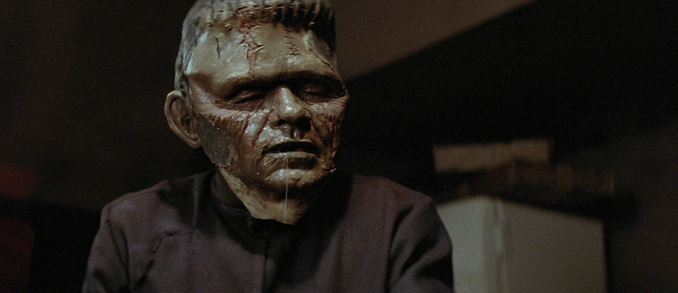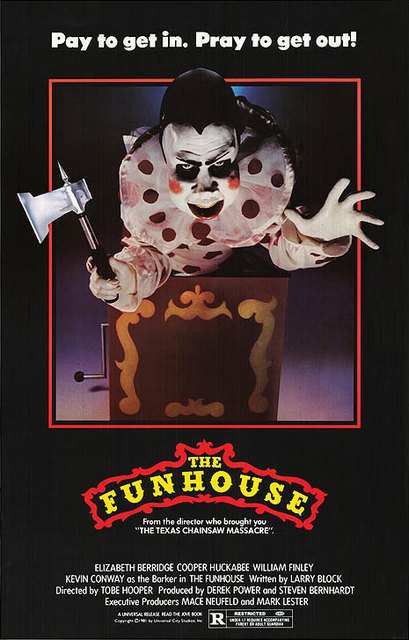“When you’re stoned, Charles Manson is a terrific guy.” – The Funhouse
I dare you to come up with a better setting for a slasher horror movie than the inside of a funhouse after the carnival shuts down for the night. I double-dare you.
Throw in direction by the man who brought the world The Texas Chainsaw Massacre, and you have all the ingredients for a horror classic. But does The Funhouse (1981) deliver the scares?
The setup oozes potential. Four teens, two boyfriend-girlfriend pairs, visit a seedy carnival and decide to do the unthinkable – spend the night inside. The story follows Amy Harper, played by Elizabeth Berridge. Amy is a quiet, shy girl who isn’t sure how far she really wants the sexual relationship with her boyfriend to progress. Okay, nothing we haven’t seen in countless other teen horror movies.
After purchasing tickets for the funhouse ride, they bail from their cars in the middle of the ride while the carnival workers aren’t looking. Unbeknownst to the teens, Amy’s little brother, Joey, a horror nut who likes to play scary pranks on his sister, has followed the teens to the carnival. Joey is the only one who notices when the teens never emerge from the funhouse.
To this point, the movie seems to be moving along perfectly. But once inside the funhouse, the movie begins to fall short of my heightened expectations. For one thing, I never feel immersed in this perfect setting. The camera shows bits and pieces of the funhouse, but I never get a sense of the internal creepiness. In my opinion, a few scenes could have utilized a point of view camera to immerse viewers.
A disturbing murder scene follows; the teens spy the killing through a crack in the floorboards. A carnival worker hiding behind a Frankenstein mask turns out to be a hideous monster once unmasked. As it turns out, the monster gets a little too excited now and then and decides to kill people, which always requires a coverup. The teens learn the monster has killed people in other towns, and they are about to escape unscathed, but…
One of the boys drops an item through the crack in the floor. Now the monster is aware of the teens’ presence. Let the stalk-and-murder commence!
While I’m a fan of Funhouse, I feel the movie falls short of its limitless potential. The monster/killer/thing appears disturbing yet is nowhere near as frightening as Hooper’s Leatherface or Carpenter’s Michael Myers. Amy, the final girl, is a survivor seemingly by pure chance rather than fortitude, and this is no more evident than in the semi-climactic final showdown.

I always feel I am being too hard on Funhouse. Truth be told, it probably ranks in the top third of my favorite slasher horror movies. My disappointment is similar to having a child who pulls solid B’s on every report card but possesses the potential to be valedictorian. Funhouse could have, and should have, been so much more. It should rank right beside Friday the 13th as an absolute staple in the slasher horror category.
I groan whenever Hollywood rolls out another remake, but if any 1980s slasher movie deserves a remake, it might be Funhouse.
For fans of the slasher sub-genre, I recommend the The Funhouse collector’s edition on Bluray. For those of you looking for a different take on the Funhouse movie and deeper characterizations, I heartily recommend Dean Koontz’s novel adaptation. This screenplay novelization was written under Koontz’s pseudonym, Owen West. Because the film production was delayed, the book ended up being released before the film reached theaters.
“The Funhouse” vs. “The Texas Chainsaw Massacre”
Tobe Hooper, a master of horror, has given fans several gems within the genre. Two of his notable works are “The Funhouse” (1981) and the groundbreaking “The Texas Chainsaw Massacre” (1974). Both movies delve into the horrors that lurk beneath the surface of seemingly benign locations, but they approach their subject matter in distinct ways. Let’s explore these two cult classics side by side.
1. Setting and Atmosphere:
The Funhouse: As the title suggests, the primary setting is a carnival funhouse. Typically a place of joy and childlike wonder, Hooper turns it into a house of horrors. The colorful and playful exterior masks the terrors within, creating a sense of irony and unease.
The Texas Chainsaw Massacre: Set in rural Texas, the film employs the isolation of the countryside to heighten the horror. The desolate landscape, with its scorching sun and open spaces, becomes even more oppressive as the protagonists realize there’s nowhere to escape.
2. The Antagonist:
The Funhouse: The primary antagonist is a disfigured man in a Frankenstein mask, hidden from the world and working in the carnival. His appearance and actions are the result of both nature and nurture, as he’s been exploited by his carnival-barker father.
The Texas Chainsaw Massacre: The film introduces us to the infamous Leatherface and his deranged family. Leatherface, with his skin masks and roaring chainsaw, embodies primal terror. The family, comprising of cannibals, adds layers of horror with their disturbing dinner table scenes and morbid sense of humor.
3. Themes and Motifs:
The Funhouse: The film explores the idea of appearances vs. reality. The carnival, meant to entertain, hides genuine horrors behind its facade. It touches upon exploitation, both in terms of the disfigured man being used for financial gain and the teenagers who become victims of their curiosity.
The Texas Chainsaw Massacre: This movie delves deeply into the breakdown of the American dream, family dysfunction, and the horrors of isolation. It showcases the degradation of humanity when removed from societal norms. The use of a chainsaw and the motif of skinning victims also make a commentary on industrialization and commodification.
4. Reception and Legacy:
The Funhouse: While not as critically acclaimed or as impactful as “The Texas Chainsaw Massacre,” “The Funhouse” has its own dedicated following. It’s praised for its atmosphere, use of color, and the symbolic play on the innocent setting of a carnival.
The Texas Chainsaw Massacre: Widely regarded as one of the most influential horror films ever made, it has left an indelible mark on the genre. Its raw, documentary-style approach and gritty realism made it an immediate subject of controversy, but it’s since been lauded for its innovative techniques, social commentaries, and its ability to terrify without excessive gore.



One thought on “The Funhouse – Tobe Hooper”
I totally agree with you on this one, Mr. Padavona. It had all the ingredients of a cult classic — the creepy setting and a creepier killer who could have been one of the best movie monsters ever. But the filmmakers seemed unwilling to take any chances. Surprising since Hooper helmed it. I still remember that Frankenstein mask to this day. But Hooper gave us THE TEXAS CHAINSAW MASSACRE, so all is forgiven. I think Hooper did POLTERGEIST the following year, so maybe he was trying to show restraint to attract more work in the mainstream.